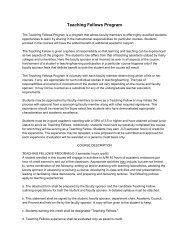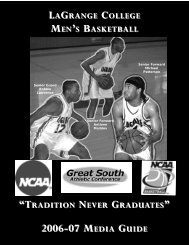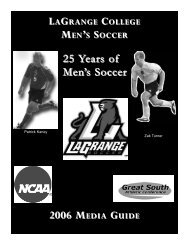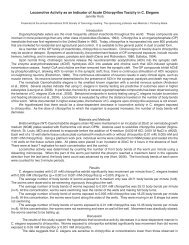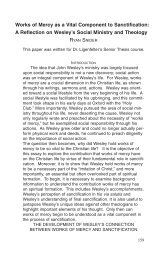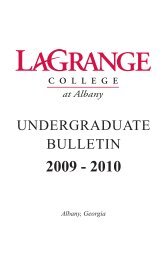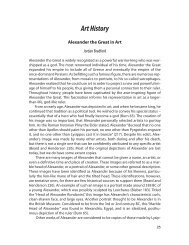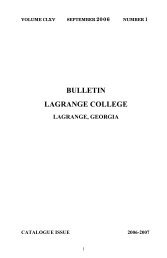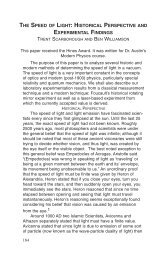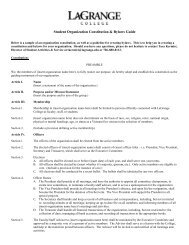undergraduate bulletin - LaGrange College
undergraduate bulletin - LaGrange College
undergraduate bulletin - LaGrange College
You also want an ePaper? Increase the reach of your titles
YUMPU automatically turns print PDFs into web optimized ePapers that Google loves.
Repeated courses, for which a passing grade was previously awarded, are included in<br />
attempted hours and grade point average calculation but not in earned hours.<br />
Example of Rate of Progress Calculation:<br />
At the end of the Fall semester, Jonathan had attempted 30 semester hours and passed (earned)<br />
21 credit hours. Jonathan‘s rate of progress (pace) would be determined by dividing the 21 credit<br />
hours he has earned by the total hours attempted, which is 30. His rate of progress is 70%<br />
(21/30). Jonathan would be considered to be meeting the quantitative standard.<br />
MAXIMUM TIME FRAME<br />
By federal regulation, a student is expected to complete the degree program within 150% of the<br />
credit hours required to complete the degree program. For example, an <strong>undergraduate</strong> student<br />
pursuing a Chemistry degree, which has a total of 120 semester hours, as published in the<br />
Undergraduate Bulletin, could receive financial aid for no more than 180 semester hours.<br />
Frequent withdrawals from courses or school, changes of major, failed or repeated courses, or<br />
taking courses that are not related to the degree program could jeopardize financial aid<br />
eligibility. All attempted hours at <strong>LaGrange</strong> <strong>College</strong> and transfer credits accepted into the degree<br />
program will count toward the maximum time frame. A student‘s eligibility for financial aid will<br />
terminate at the time the student has completed the required coursework in the degree program or<br />
when it is determined that the student has exceeded the 150% maximum time frame, or it is<br />
determined that it is mathematically impossible for the student to complete the degree program<br />
within the maximum timeframe.<br />
The following are considered when evaluating the time frame standard:<br />
• A student pursuing two (2) bachelors‘ degree programs at the same time must adhere to<br />
the 150% time frame. The maximum attempted hours allowable for financial aid will be<br />
based on the degree that requires the most hours.<br />
• Students returning to school to pursue another <strong>undergraduate</strong> degree are allowed an<br />
additional 60 semester hours to complete the degree. All other standards established in<br />
the satisfactory academic progress policy apply to subsequent <strong>undergraduate</strong> degrees. If<br />
the second degree will require more than 60 hours to complete, then the student must<br />
submit documentation from his or her advisor outlining the courses needed to complete<br />
the degree.<br />
• A transfer student‘s compliance with the time frame component of the satisfactory<br />
academic progress policy will be based on the sum of the attempted hours at <strong>LaGrange</strong><br />
<strong>College</strong> plus the credit hours accepted on transfer from previous institutions toward the<br />
student‘s degree program. For example, if a transfer student has 70 credit hours<br />
acceptable towards their degree program, then the student may receive financial<br />
assistance for up to 110 additional credit hours.<br />
SATISFACTORY ACADEMIC PROGRESS EVALUATION<br />
After final grades are reported for the semester, the academic history from all periods of<br />
enrollment, regardless of full-time or part-time enrollment status, will be reviewed to determine<br />
if the student is maintaining the standards established in the Satisfactory Academic Progress<br />
26




